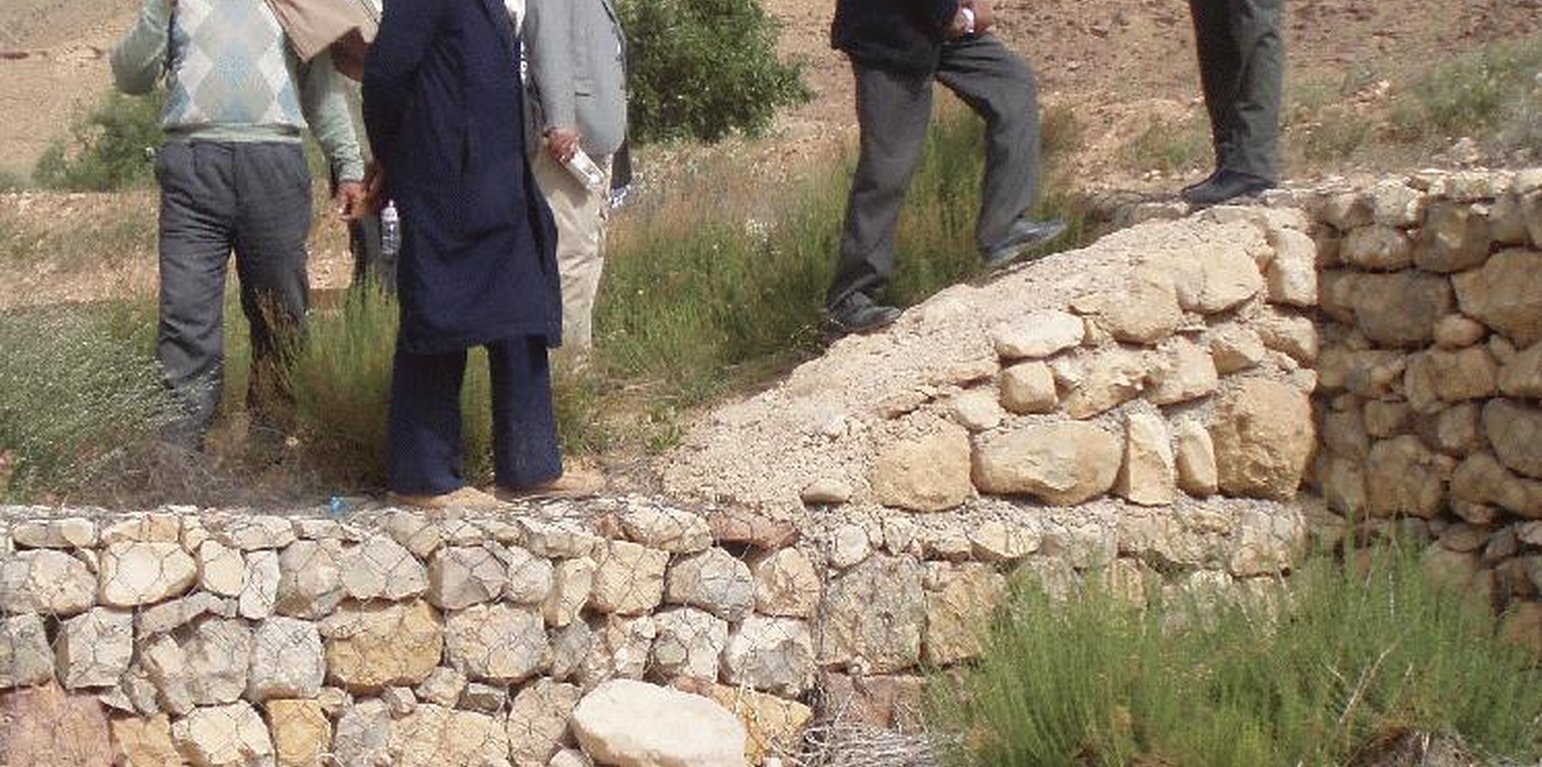Dryland watershed management approach
(ตูนิเซีย)
คำอธิบาย
Integrated land and water management approach, including vegetative, management, and agronomic measure
Aims / objectives: The overall purpose of the approach is to prevent soil and water loss by combined measures and to provide a better environment. Soil and water conservation (SWC) technologies, based on harvesting area of surface water and underground water, are implemented to conserve soil and water and to improve the production and the biodiversity.
Methods: This approach is designed for the exploitation of water runoff for agricultural development, particularly for fruit trees cropping (mainly olives).This can be achieved through erosion reduction and aquifer recharge via runoff water infiltration into the terraces, slope angle and length reduction, runoff retaining, infiltration increase and soil loss reduction. The system is based on various runoff water harvesting systems, as jessour, tabias. It is marked by fruit tree development, notably olives. On the terraces, the fruit trees are arranged in inter-rows with the three main species encountered in the study areas. Generally, olive trees are planted, with in between rows almonds and/ or fig trees. SWC technologies play an importance role in arid zones. Since the 1970s, the Tunisian state has encouraged the local population to conserve water and soil in arid zone. Successive programmes and strategies of water and soil conservation have been developed and were implemented in all three natural regions of Tunisia (North, Centre and South).These techniques can be implemented by farmer with governmental subsidies or by government intervention in the projects and programmes of water and soil conservation. During the last decade, the Tunisian government implemented the first national strategy for soil and water conservation (1990-2000) and the second national strategy for soil and water conservation (2001-2011). These strategies mobilized important funds at national and regional levels. About 672.5 ha of SWC technologies were built and about 550 ha of SWC technologies are planned for the second national strategy.
Stages of implementation: 1) Assessment of the current natural resources and socio-economic conditions; 2) Proposition of actions at local and regional level; 3) Aggregation and coherence at the national level; 4) implementation of national action plan at local and regional level.
Role of stakeholders: Different levels of intervention are observed from the individual farm, through the community level, the extension / advisory system, the regional or national administration, or the policy level, to the international framework. The participative approach is usually applied in the construction of SWC technologies.
สถานที่
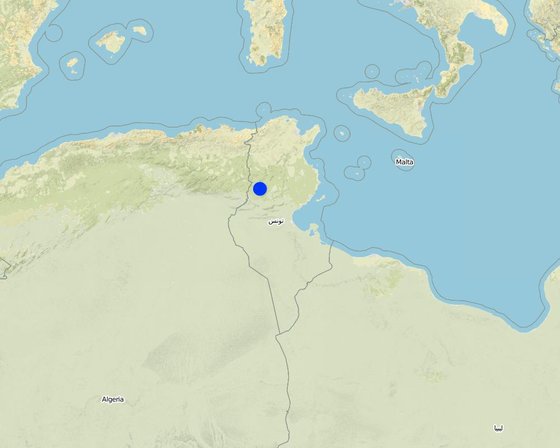
สถานที่: Oum Zessar Watershed, south-east of tunisia, ตูนิเซีย
ตำแหน่งทางภูมิศาสตร์ของสถานที่ที่ถูกเลือ
วันที่ริเริ่ม: 1960
ปีที่สิ้นสุด: n.a.
ประเภทของแนวทาง
-
แบบดั้งเดิม/ แบบพื้นเมิอง
-
เป็นนวัตกรรมท้องถิ่นล่าสุด/ นวัตกรรมใหม่
-
ใช้โครงงานหรือแผนงานเป็นฐาน
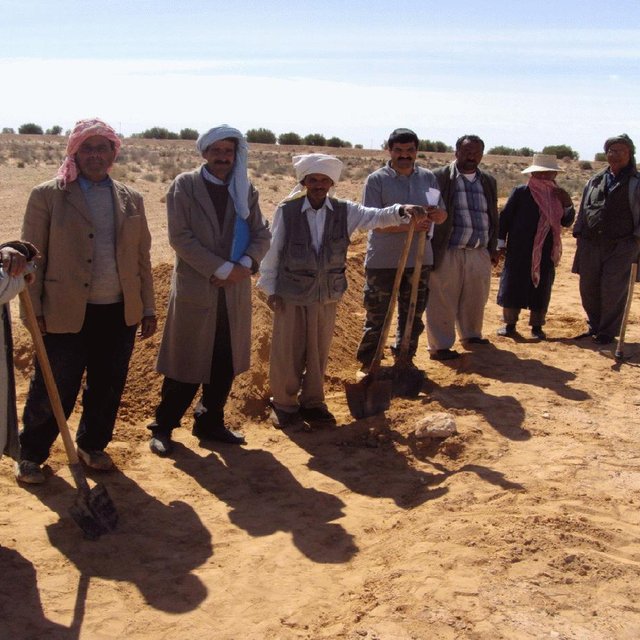
The system is based on various runoff water harvesting systems, as jessour, tabias. (Cyprien Hauser)
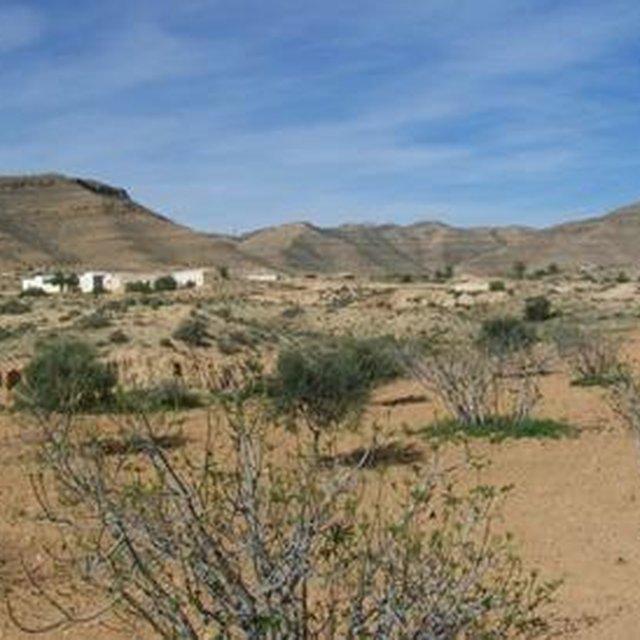
-
แนวทางการดำเนินการและบรรยากาศการพัฒนาที่เอื้ออํานวย
เป้าหมายหรือวัตถุประสงค์หลักของแนวทาง
The Approach focused on SLM only (production, soil fertility, biodiversity, employement oppourtunities, food self-sufficiency, fixing population and stop farming exodus)
The objectives of the approach are to control soil and water loss to reduce floods and enhance fertility, to enhance rainfed agriculture productivity, to improve the livelihoods of farmers, to contribute to the production increase among farmers and pastoralists, to recharge the groundwater and to extend the area of cropland.
The SLM Approach addressed the following problems: The problems originate in the scarcity of water which is leading to conflicts over resource use between farmers. Oversized techniques leading to prevention of runoff from upstream to downstream reduce agricultural production and therefore the farm income, which causes a lack of cash to invest in SLM. In some cases irreversible land degradation is the result. The problems are mainly related to the lack of technical knowledge, the high costs of investment and the lack of tangible and assessable impacts of SWC activities, technically or socially.
เงื่อนไขที่เอื้ออำนวยต่อการนำเอาเทคโนโลยีภายใต้แนวทางนี้ไปปฏิบัติใช้
-
กรอบแนวทางในการดำเนินการด้านกฎหมาย (การถือครองที่ดิน สิทธิในการใช้ที่ดินและน้ำ): The existing land ownership, land use rights / water rights greatly helped the approach implementation: The approach helped in the privatization of the land and has therefore greatly reduced the land/water use rights problems. This in turn has rendered the local interventions much more efficient.
เงื่อนไขที่เป็นอุปสรรคต่อการนำเอาเทคโนโลยีภายใต้แนวทางนี้ไปปฏิบัติใช้
-
การมีไว้ให้หรือการเข้าถึงแหล่งการเงินและบริการ: High cost investment
Treatment through the SLM Approach: Public projects (National strategy of SWC), subsidies
-
การจัดตั้งระดับองค์กร: Land fragmentation, complexity of land tenure,
Treatment through the SLM Approach: Users organisation, participation
-
ความรู้เกี่ยวกับ SLM การเข้าถึงการสนับสนุนด้านเทคนิค: Designing parameters
Treatment through the SLM Approach: Training , Ehancing SWC specialists guidance
การมีส่วนร่วมและบทบาทของผู้มีส่วนได้เสีย
ผู้มีส่วนได้เสียที่เกี่ยวข้องในแนวทางนี้และบทบาท
| ผู้มีส่วนได้เสียหรือองค์กรที่นำไปปฏิบัติใช้มีส่วนเกี่ยวข้องกับแนวทางนี้อย่างไร |
ระบุผู้มีส่วนได้ส่วนเสีย |
อธิบายบทบาทของผู้มีส่วนได้ส่วนเสีย |
| ผู้ใช้ที่ดินระดับท้องถิ่นหรือชุมชนระดับท้องถิ่น |
Working land users were mainly men (Men are the main force for field work.) |
Special attention has been paid to make women participate in the approach. Nevertheless, men have much more technical knowledge and skills than women because if SWC technologies have to be constructed by manual labour, men can achieve more. Poor and old people are especially involved through their participation in the special programme against unemployment in rural area. Some unemployed young people may benefit from agricultural development programmes. |
| ผู้เชี่ยวชาญ SLM หรือที่ปรึกษาการเกษตร |
|
The choice on the technology to use is made primarily by the technical specialists based on the prevalent type of erosion on each farm and farmers preference. |
| รัฐบาลแห่งชาติ (ผู้วางแผน ผู้ทำการตัดสินใจ) |
|
|
| องค์การระหว่างประเทศ |
|
|
เอเจนซี่หลัก
National and state specialists together with land users.
การเกี่ยวข้องของผู้ใช้ที่ดินระดับท้องถิ่นหรือชุมชนระดับท้องถิ่นในช่วงต่าง ๆ ของแนวทาง
ไม่มี
ไม่ลงมือ
จ่ายเงินหรือสนับสนุนจากภายนอก
ปฏิสัมพันธ์
ระดมกำลังด้วยตนเอง
การริเริ่มหรือการจูงใจ
Farmers and local population are very familiar with traditional SWC applied. Therefore the receptiveness to these techniques is very high. There is state encouragement through subsidies.
การวางแผน
Workshops/seminars; After a programme is granted, the implementing agency and local communities work together.
การดำเนินการ
Responsibilities are divided into major steps; In practice, local communities are the major part to manage and carry out.
การติดตามตรวจสอบหรือการประเมินผล
Participative evaluation; Interviews/questionnaires.
Research
It can give some suggestions or questionnaires.
แผนผัง
The treatment of the catchment starts from the upstream and continues to piedmont areas, and ends in the downstream section of the catchment. Attention should be given to ensure sufficient water allocation to all the sections of the catchment as well as to the different users (rainfed agriculture and rangelands, irrigated areas, drinking water, industry and tourism).
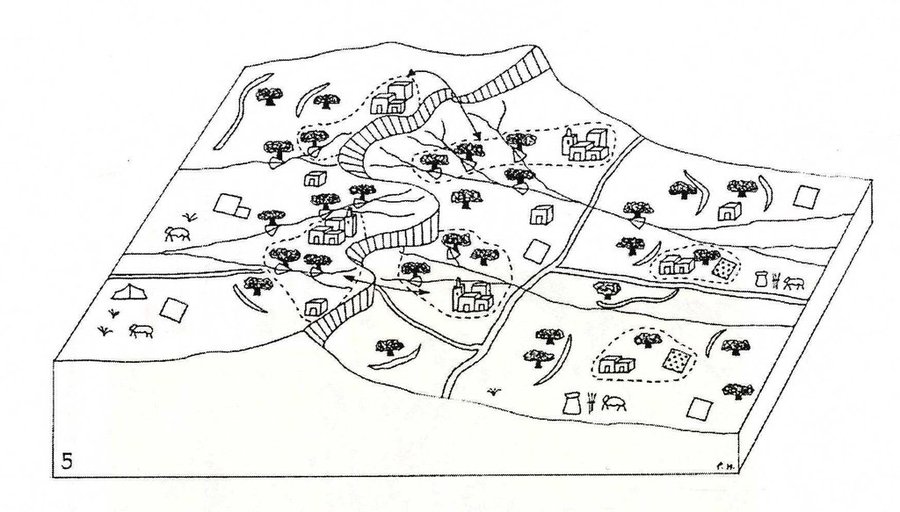
ผู้เขียน Patricia Home
การตัดสินใจในการเลือกใช้เทคโนโลยี SLM
การตัดสินใจถูกทำโดย
-
ผู้ใช้ที่ดินเพียงผู้เดียว ( ริเริ่มด้วยตัวเอง)
-
ผู้ใช้ที่ดินเป็นผู้ตัดสินใจหลัก โดยการสนับสนุนจากผู้เชี่ยวชาญ SLM
-
ผู้ลงมือปฏิบัติที่เกี่ยวข้องทั้งหมดในฐานะที่เป็นส่วนรวมของแนวทาง
-
ผู้เชี่ยวชาญ SLM เป็นผู้ตัดสินใจหลัก ที่ติดตามให้คำปรึกษากับผู้ใช้ที่ดิน
-
ผู้เชี่ยวชาญ SLM เพียงผู้เดียว
-
นักการเมืองหรือผู้นำ
การตัดสินใจถูกตัดสินอยู่บนพื้นฐานของ
-
การประเมินความรู้ SLM ที่ได้ทำการบันทึกไว้เป็นอย่างดี (การใช้ข้อมูลในการตัดสินใจ)
-
สิ่งที่ค้นพบจากงานวิจัย
-
ประสบการณ์และความคิดเห็นส่วนตัว (ไม่ได้ลงบันทึกไว้)
การสนับสนุนด้านเทคนิค การสร้างขีดความสามารถ และการจัดการด้านความรู้
กิจกรรมหรือการบริการต่อจากนี้เป็นส่วนหนึ่งของแนวทาง
-
การสร้างขีดความสามารถ / การอบรม
-
การบริการให้คำแนะนำ
-
การเสริมความแข็งแกร่งให้กับสถาบัน (การพัฒนาองค์กร)
-
การติดตามตรวจสอบและประเมินผล
-
การวิจัย
การสร้างสมรรถภาพหรือการอบรม
การจัดอบรมถูกจัดขึ้นสำหรับผู้มีส่วนได้ส่วนเสียต่อไปนี้
-
ผู้ใช้ที่ดิน
-
เจ้าหน้าที่ภาคสนาม / ที่ปรึกษา
รูปแบบของการอบรม
-
กำลังดำเนินการ
-
เกษตรกรกับเกษตรกร
-
ใช้พื้นที่ทำการสาธิต
-
จัดการประชุมสู่สาธารณชน
-
จัดคอร์ส
หัวข้อที่อบรม
Training focused on teaching them how to design and build SWC technologies, how to implement these technologies and about the participatory approach.
การบริการให้คำแนะนำ
การให้คำแนะนำถูกจัดขึ้น
-
ไปเยี่ยมชมสถานที่
-
ที่ศูนย์ถาวร
Name of method used for advisory service: Integrated watershed management; Key elements: Training and demonstration open days, Demonstration plots implemented in private farms, Target farmers groups are visited by specialist to help and advise them.; 1) Advisory service was carried out through: government's existing extension system. Extension staff: mainly government employees 3) Target groups for extension: planners; Activities: training
Advisory service is quite adequate to ensure the continuation of land conservation activities; The extension system is adequate to ensure continuation of activities. At each governorate level, there is a SWC division which is in charge of SWC activities, including its extension.extension
การสร้างความแข็งแกร่งให้กับองค์กร
องค์กรถูกทำให้แข็งแกร่งขึ้นหรือจัดตั้งขึ้น
-
ไม่
-
ใช่ เล็กน้อย
-
ใช่ ปานกลาง
-
ใช่ อย่างมาก
อธิบายถึงสถาบัน บทบาทและความรับผิดชอบ สมาชิก เป็นต้น
ประเภทของการให้ความช่วยเหลือสนับสนุน
-
ด้านการเงิน
-
การสร้างขีดความสามารถ / การอบรม
-
อุปกรณ์
รายละเอียดเพิ่มเติม
support with financial resources, capacity building, training, institutional support. The financial schema is made of three main components: self-financing from farmers and beneficiaries, subsidies from the government and credit from bank.
การติดตามตรวจสอบและประเมินผล
economic / production aspects were ad hoc monitored by project staff through measurements; indicators: investigation/ of yield, income of land users, rainfed productivity
socio-cultural aspects were ad hoc monitored by project staff through observations; indicators: Investigation of land users perceptions of cultural change
bio-physical aspects were ad hoc monitored by project staff through measurements; indicators: Indicators are runoff loss, sediment load, soil moisture
area treated aspects were ad hoc monitored by government through measurements; indicators: Impact assessment
management of Approach aspects were None monitored by government through measurements; indicators: None
There were few changes in the Approach as a result of monitoring and evaluation: for example at the institutional level.
การวิจัย
การวิจัยกระทำกับหัวข้อต่อไปนี้
-
สังคมวิทยา
-
เศรษฐศาสตร์หรือการตลาด
-
นิเวศวิทยา
-
เทคโนโลยี
-
approaches
Land users have been involved. SWC technologies construction is based on scientific design, according to local conditions.
Research was carried out both on station and on-farm
การสนับสนุนด้านการเงินและวัสดุอุปกรณ์
งบประมาณประจำปีสำหรับองค์ประกอบ SLM เป็นจำนวนดอลลาร์สหรัฐ
-
< 2,000
-
2,000-10,000
-
10,000-100,000
-
10,000-100,000
-
> 1,000,000
Precise annual budget: n.a.
Approach costs were met by the following donors: local community / land user(s): 20.0%; national non-government: 5.0%; government: 55.0%; international: 20.0%
การบริการหรือแรงจูงใจต่อจากนี้ได้ถูกจัดให้สำหรับผู้ใช้ที่ดิน
-
การสนับสนุนด้านการเงิน / วัสดุอุปกรณ์ให้แก่ผู้ใช้ที่ดิน
-
เงินสนับสนุนสำหรับปัจจัยการผลิต
-
เครดิต
-
แรงจูงใจหรือเครื่องมืออื่น ๆ
การสนับสนุนด้านการเงินและวัสดุอุปกรณ์ให้แก่ผู้ใช้ที่ดิน
ได้รับการช่วยเหลือทางการเงินบางส่วน
ได้รับการช่วยเหลือทางการเงินแบบเต็ม
วัสดุสำหรับการก่อสร้าง: หิน
แรงงานของผู้ใช้ที่ดินคือ
-
สมัครใจ
-
อาหารสำหรับการทำงาน
-
จ่ายเป็นเงินสด
-
ให้ค่าตอบแทนด้วยการสนับสนุนด้านวัสดุอุปกรณ์อื่น ๆ
เครดิต
-
ข้อกำหนด repayment conditions: Credit was promoted through agricultural banks with various interest rates, usually lower than market rates.
-
ผู้ให้เครดิต n.a.
-
ผู้รับเครดิต n.a.
ผลกระทบและสรุปคำบอกกล่าว
ผลกระทบของแนวทาง
ไม่ใช่
ใช่ เล็กน้อย
ใช่ ปานกลาง
ใช่ อย่างมาก
ช่วยให้ผู้ใช้ที่ดินนำเอาเทคโนโลยี SLMไปใช้และบำรุงรักษาสภาพไว้ได้หรือไม่
Land users can harvest water and irrigate crops in dry seasons. Meanwhile, the cropland area is enlarged.
ทำให้กลุ่มด้อยโอกาสมีอำนาจทางสังคมและเศรษฐกิจหรือไม่
for disadvantaged women and men, there are employment opportunities and food self-sufficiency
ปรับปรุงประเด็นของการถือครองที่ดินหรือสิทธิในการใช้ ซึ่งขัดขวางการนำเทคโนโลยีไปใช้ให้ดีขึ้น
Did other land users / projects adopt the Approach?
แรงจูงใจหลักของผู้ใช้ที่ดินเพื่อที่จะนำ SLM ไปปฏิบัติใช้
-
การผลิตที่เพิ่มขึ้น
-
กำไร (ความสามารถ) อัตราส่วนค่าใช้จ่ายต่อผลประโยชน์ที่เพิ่มขึ้น
-
การเสื่อมของที่ดินลดลง
-
ความเสี่ยงของภัยพิบัติลดลง
-
ภาระงานลดลง
-
การจ่ายเงินหรือการช่วยเหลือ
-
กฎและระเบียบ (ค่าปรับ) หรือการบังคับใช้
-
เกียรติภูมิ แรงกดดันทางสังคม ความเชื่อมแน่นทางสังคม
-
การเข้าร่วมสมทบในขบวนการ โครงการ กลุ่ม เครือข่าย
-
จิตสำนึกด้านสิ่งแวดล้อม
-
ประเพณีและความเชื่อ ศีลธรรม
-
ความรู้และทักษะ SLM ที่เพิ่มพูนขึ้น
-
การปรับปรุงด้านสุทรียภาพ
-
การบรรเทาด้านความขัดแย้ง
-
well-being and livelihoods improvement
ความยั่งยืนของกิจกรรมของแนวทาง
ผู้ใช้ปที่ดินสามารถทำให้สิ่งต่างๆ ที่ได้ปฏิบัติใช้โดยแนวทางนี้ยั่งยืนได้หรือไม่ (โดยไม่มีการสนับสนุนจากภายนอก)?
บทสรุปหรือบทเรียนที่ได้รับ
จุดแข็ง: มุมมองของผู้ใช้ที่ดิน
-
Reduction of soil erosion (How to sustain/ enhance this strength: ensure the durability of the works implemented)
จุดแข็ง: ทัศนคติของผู้รวบรวมหรือวิทยากรคนอื่นๆ
-
Improvement of livelihood (How to sustain/ enhance this strength: spreading and improvement of a more holistic SLM approach focusing on livelihoods)
-
Many people involved and trained at different levels (pyramid system) (How to sustain/ enhance this strength: participatory approach)
-
More participation and involvement of local population (How to sustain/ enhance this strength: Improve participatory approach and increase confidence between partners)
จุดด้อย/ข้อเสีย/ความเสี่ยง: มุมมองของผู้ใช้ที่ดินแก้ไขปัญหาได้อย่างไร
-
Abandonment of the works, less maintenance
Continue to support farmers and local institution and organisation. Repairing and maintaining in time.
-
Low impact on livelihood conditions
improve efficiency of SWC activities and participatory approach
จุดด้อย/ข้อเสีย/ความเสี่ยง: ทัศนคติของผู้รวบรวมหรือวิทยากรคนอื่นๆแก้ไขปัญหาได้อย่างไร
-
Less confidence between partners and less participation
improve dialog and communication; improve efficiency of SWC activities and participatory approach.
-
High costs: farmers depend on external support from the government; they are not willing to invest their labour without payments
New approach should give farmers loans for construction as now they use machines to do the work. In addition, search for cheaper SWC technologies and for improving the benefits.
การอ้างอิง
ผู้ตรวจสอบ
-
Fabian Ottiger
-
Deborah Niggli
วันที่จัดทำเอกสาร: 9 มิถุนายน 2009
การอัพเดทล่าสุด: 4 เมษายน 2018
วิทยากร
-
Naceur Mahdi (naceur.mahdhi@ira.rnrt.tn) - ผู้เชี่ยวชาญ SLM
-
Mohamed Ouessar (ouessar.mohamed@ira.rnrt.tn) - ผู้เชี่ยวชาญ SLM
-
Mongi Sghaier (sghaier.mon@gmail.com) - ผู้เชี่ยวชาญ SLM
คำอธิบายฉบับเต็มในฐานข้อมูล WOCAT
การจัดทำเอกสารถูกทำโดย
องค์กร
- Institut des Régions Arides de Médenine (Institut des Régions Arides de Médenine) - ตูนิเซีย
โครงการ
การอ้งอิงหลัก
-
Genin D., Guillaume H., Ouessar M., Ouled Belgacem A., Romagny B., Sghaier M., Taamallah H. (Eds) 2006. Entre la désertification et le développement : la Jeffara tunisienne. CERES, Tunis; de Graaff J. & Ouessar M. (Eds.) 2002Water harvesting in Mediterranean zones: an impact assessment and economic evaluation. : TRMP paper n° 40, Wageningen University, The Netherlands
-
Water harvesting in Mediterranean zones: an impact assessment and economic evaluation. : TRMP paper n° 40, Wageningen University, The Netherlands
